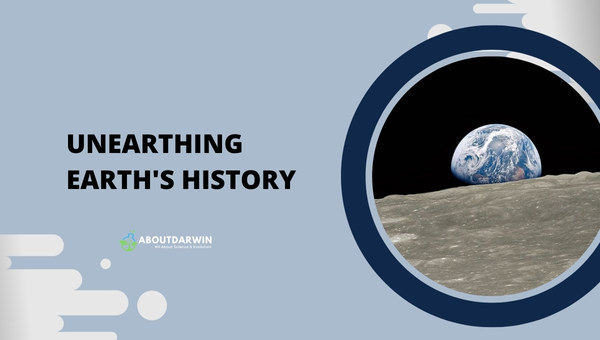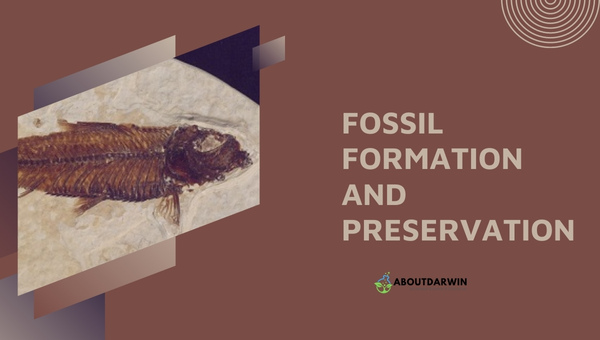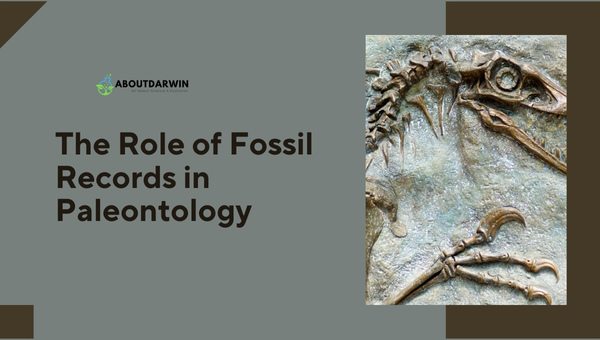Physical Address
304 North Cardinal St.
Dorchester Center, MA 02124
Fossil records offer us a glimpse into the past as they stand as undeniable evidence of the existence of ancient life on Earth. These records, which can be found in the various layers of sedimentary rocks, showcase the story of our planet, its inhabitants, and its evolution over billions of years. By examining these preserved remnants, I can piece together the history of life on Earth, like clues in a biological detective story.
The analysis of fossil records unlocks significant knowledge about extinct species, their adaptations, and their interactions with other species and the environment. It aids in understanding the evolutionary processes and how ecosystems change over time.
When I take a closer look at these records, I’m not only gaining a better understanding of our planet’s history, but also learning valuable lessons about its future.
While exploring these fascinating relics of the past, I can find myself uncovering answers to long-standing questions about the development of Earth’s biodiversity, and unearthing facts about our planet’s climatic and geological changes.
This journey through the fossil records is more than just flipping through the pages of a prehistoric photo album, it’s an adventure that allows me to connect with some of the most significant events in our planet’s history.
Contents
Let me take you on a journey into the mysterious world of fossil records. These fascinating remnants of the past help us reconstruct Earth’s history piece by piece.

Fossil records are essential to understanding the story of life on our planet. By analyzing fossils, we can decipher the evolutionary patterns and gain valuable insights into the environment and conditions that prevailed at that time. It’s incredible how a petrified residue of a long-extinct organism can unveil such detailed information about Earth’s past.
While fossils come in many shapes and sizes, they can be classified into three main categories: body, trace, and chemical. Each category provides unique information about ancient life forms.
Thanks to modern technology, we can use various tools to analyze fossils, including radiometric dating, CT scans, and isotopic analyses. This has enabled scientists to construct intricate and accurate timelines, mapping our planet’s various stages of evolution.
A fascinating example of what fossils can teach us is the Irish Elk, Megaloceros giganteus, a magnificent herbivore that lived during the Pleistocene epoch. With antlers spanning up to 12 feet, it is believed to have gone extinct around 7,700 years ago. By examining its fossils, scientists could estimate its weight, diet, and environment, enabling them to generate an accurate representation of this ancient creature.
The following table summarizes the key details about fossil records, highlighting their importance as time capsules of Earth’s history:
| Importance of Fossil Records | Examples |
|---|---|
| Evolutionary patterns | Path of evolution from single-celled organisms to complex life forms |
| Environment and conditions | Climate fluctuations, sea level changes, and tectonic events |
| Classification of organisms | Body, trace, and chemical fossils |
| Technological advancements | Radiometric dating, CT scans, and isotopic analyses |
It’s remarkable to think that something as seemingly insignificant as a fossil has the power to unravel the mysteries of Earth’s history. As we continue to unearth and study these ancient remnants, we steadily build a clearer picture of the past, enriching our understanding of the wondrous journey that life has taken on our planet.
Fossils provide us with invaluable insights into the past, but how do they form, and how are they preserved? In this section, I’ll delve into the process of fossilization and the factors that contribute to a fossil’s preservation.

Fossil formation occurs mainly through two methods: mineralization and carbonization. Here’s a brief overview of each type:
While the formation process might seem straightforward, several factors can influence a fossil’s preservation. Here are some of the major factors:
Some fascinating statistics about fossil records:
| Period | Million Years Ago | Percentage of Fossils |
|---|---|---|
| Cambrian | 540-485 | 13% |
| Ordovician | 485-444 | 14% |
| Silurian | 444-419 | 9% |
| Devonian | 419-359 | 15% |
| Carboniferous | 359-299 | 14% |
| Permian | 299-252 | 8% |
| Triassic | 252-201 | 5% |
| Jurassic | 201-145 | 9% |
| Cretaceous | 145-66 | 9% |
| Tertiary | 66-2.58 | 2% |
When it comes to the preservation of fossils, two main categories exist: unaltered and altered. Unaltered fossils retain much of their original composition, while altered fossils undergo structural and compositional changes during the fossilization process. The preservation of fossils is key to understanding our planet’s distant past and the life forms that once inhabited it.
With each new discovery, we unlock further details about their lives and environments, shedding light on our planet’s rich history.
As a paleontologist, I know that fossil records play a crucial role in understanding the history of life on Earth. These preserved remains or traces of organisms help us unlock the mysteries of evolution, ecological changes, and the extinction of countless species.

One important aspect of studying fossil records is dating. We use various methods, like radiometric dating, to determine the age of fossils. This information allows us to construct a chronological sequence of life’s history. Here’s a simple table to illustrate common fossil dating techniques:
| Technique | Time Range (in years) |
|---|---|
| Radiocarbon | Up to 50,000 |
| Potassium-Argon | 100,000 to billions |
| Uranium-Lead | Over 1 million |
Fossil records also play a key role in understanding evolutionary relationships. We can discover their shared ancestry and construct phylogenetic trees by comparing anatomical features and DNA of organisms preserved in fossils. These trees illustrate the evolutionary pathways through which various species diverged from common ancestors.
Another essential function of fossil records in paleontology is exploring extinction events. By examining the disappearance of species over time, we can learn about factors that might have contributed to their extinction. Here’s a summary of major extinction events in Earth’s history:
To study paleoecology, I analyze fossil records to understand the distribution and diversity of organisms during different periods. This information provides insights into ancient habitats, climate change, and how ecosystems recovered after catastrophic events like volcanic eruptions and asteroid impacts.
In my field, I also use fossil records to examine the development of morphological features in ancient organisms. This means studying changes in body parts’ shape, size, and function over time. For example, I might research how dinosaurs developed feathers or how the mammalian ear evolved.
Finally, fossil records offer a unique window into extinct organisms’ behavior and life cycles. We can learn how they fed, reproduced, migrated, or even cared for their young by looking at preserved footprints, nests, or carcasses.
The discoveries made from these records continue to enhance our understanding of the complex story of life on Earth.
When delving into the realm of fossil records, it’s essential to clearly understand the various dating techniques used by paleontologists and geologists. These methods help us accurately determine the age of fossils, giving us a more accurate picture of our planet’s history. In this section, I’ll discuss some widely-used dating techniques.
Relative dating is the first step in estimating a fossil’s age. This method is based on the principle of superposition, which states that older layers of sedimentary rock are found beneath younger layers. Geologists use this principle to determine a rough age bracket for fossils. Some key elements of relative dating include:
While relative dating can provide an age range, it doesn’t give us an exact age. That’s where absolute dating techniques come in. These methods give a more precise timeframe by using the rates of decay of radioactive elements. Two common absolute dating techniques are:
Here’s a comparison of these dating techniques in a simple table format:
| Technique | Type | Application | Effective Range |
|---|---|---|---|
| Stratigraphy | Relative | Layers of rock | N/A |
| Index fossils | Relative | Specific fossils | N/A |
| Cross-cutting relationships | Relative | Geological intersections | N/A |
| K-Ar dating | Absolute | Volcanic rocks | 4.3 billion – a few thousand years |
| U-Pb dating | Absolute | Zircon crystals | Almost entire Earth age |
| Carbon-14 dating | Absolute | Organic materials | Up to 50,000 years |
Each method has its limitations, combining multiple approaches can provide a much more accurate and comprehensive view of our planet’s past.
Fossils are our window into the past, offering a glimpse of the rich history of life on Earth. In this section, I’ll explore some of the most famous fossil discoveries and their impact on our understanding of prehistoric life.
Archaeopteryx, discovered in Germany in the 1860s, is considered one of the most important fossils ever found. As a transitional organism between dinosaurs and birds, Archaeopteryx helped to confirm the theory of evolution proposed by Charles Darwin. Scientists now recognize this creature as an early example of dinosaurs evolving into birds.
Another notable discovery is Australopithecus afarensis, popularly known as “Lucy.” Discovered in Ethiopia in 1974, Lucy has provided invaluable insights into human evolution. Her partial skeleton reveals a shared ancestry with modern humans and evidence of bipedalism, which is walking on two legs. Lucy’s discovery has profoundly impacted the study of human origins.
Tiktaalik roseae is another impactful find in the world of paleontology. Discovered in 2004 in the Canadian Arctic, Tiktaalik is regarded as a key transitional fossil between fish and the first land-dwelling, four-legged animals called tetrapods. Tiktaalik’s features include fish-like scales, fins, and gills, but it also possessed tetrapod-like limbs and a robust ribcage, suggesting the potential for breathing air and supporting its weight on land.
Finally, we have the Sue T. rex fossil, one of the most complete and well-preserved Tyrannosaurus rex skeletons ever discovered. Found in South Dakota in 1990, Sue has given paleontologists a wealth of information about one of the most iconic dinosaurs. Sue’s discovery has helped to shed light on T. rex’s posture, growth rate, and even its potential social behavior.
These are just a few examples of the countless fossils that have shaped our understanding of the history of life on Earth. From confirming evolutionary theories to giving us valuable insights into the lives of long-extinct organisms, these famous discoveries have had a lasting impact in the field of paleontology and beyond.
I believe fossil research’s future holds many exciting developments and discoveries. As technologies continue to advance, we can expect further breakthroughs in our understanding of Earth’s past and the evolution of life.
One area of focus in the coming years will likely be exploring new fossil sites. In recent years, satellite imagery and remote sensing technologies have helped researchers identify previously unknown locations with potential fossil-rich deposits. As more sites are discovered, we’ll get a clearer picture of Earth’s history – bridging gaps in our knowledge and possibly encountering entirely new species.
Another development that could revolutionize fossil research is advanced imaging techniques, such as 3D scanning and virtual reconstruction. This technology allows paleontologists to examine fossils digitally and, in some cases, virtually restore them to their original state.
By doing so, they’ll be able to better understand extinct organisms’ anatomy, function, and behavior. These advanced techniques have already provided new insights into the lives of dinosaurs and early mammals.
Fossil research will also benefit from interdisciplinary collaboration involving scientists from various fields. By partnering with experts in fields like geochemistry, geophysics, and molecular biology, paleontologists can get a more comprehensive understanding of key topics. For example:
Furthermore, artificial intelligence (AI) will play an increasingly important role in fossil research. Machine learning algorithms have already shown immense potential for identifying and analyzing fossils within large data sets. The power of AI to rapidly process massive amounts of data could lead to uncovering previously unrecognized patterns and relationships.
By leveraging these tools and discoveries, we’ll continue building our understanding of Earth’s past, untangling the mysteries of our planet’s history, and unearthing the incredible stories of ancient life.
It’s been a fascinating journey exploring fossil records and delving into the rich history of our Earth. I’ve gained a deeper understanding of how these preserved remains allow scientists to reconstruct ancient ecosystems and piece together the evolutionary puzzle.
By examining fossils, I’ve observed how scientists can uncover crucial information about extinct species, including their:
While the fossil record may have its limitations, such as gaps and biases, it remains a valuable resource for understanding our planet’s history. Advancements in research techniques, such as:
They have greatly enhanced our ability to extract valuable insights from these ancient remains.
I’ve also come to appreciate the ongoing dedication of researchers who passionately work towards discovering new fossils and filling in the gaps in our knowledge. Their discoveries help us understand our world better, revealing new insights that contribute to the fields of paleontology, biology, and Earth sciences.
The diverse fossil record connects us to the-often-mysterious past through which we learn key information about Earth’s history, evolution, and the story of life on our planet. As we continue unearthing these hidden clues, we’ll keep gaining a richer, more comprehensive understanding of the wonderful tapestry of life unfolding on our planet over millions of years.